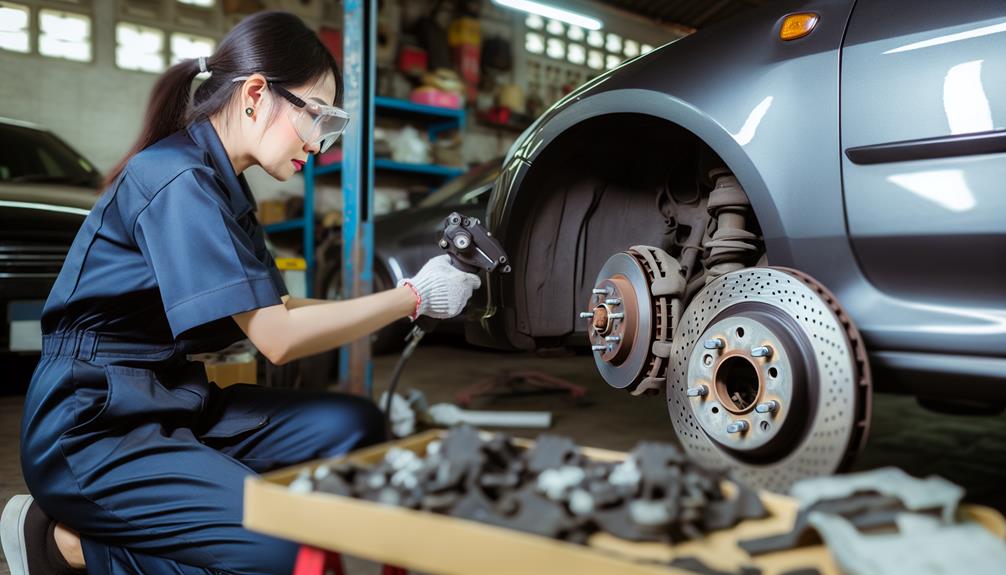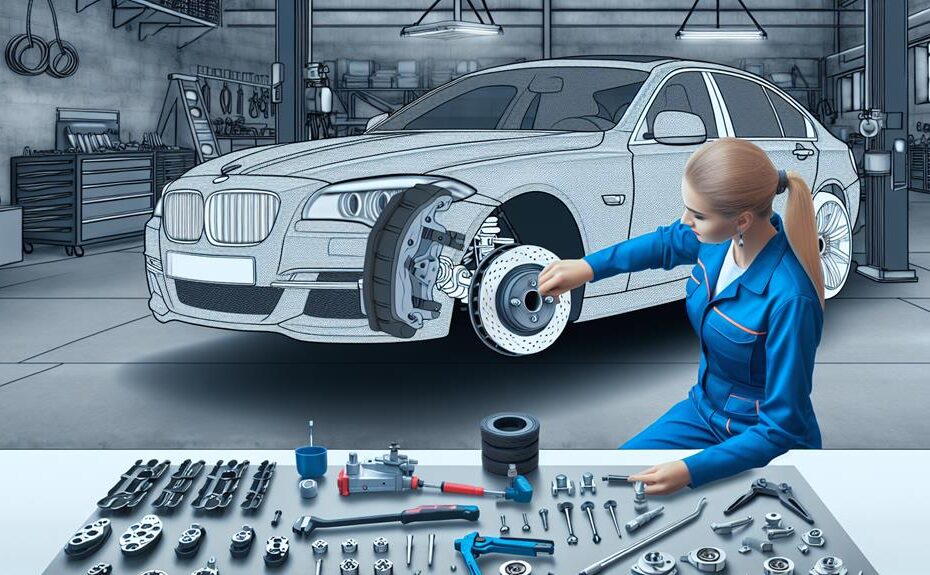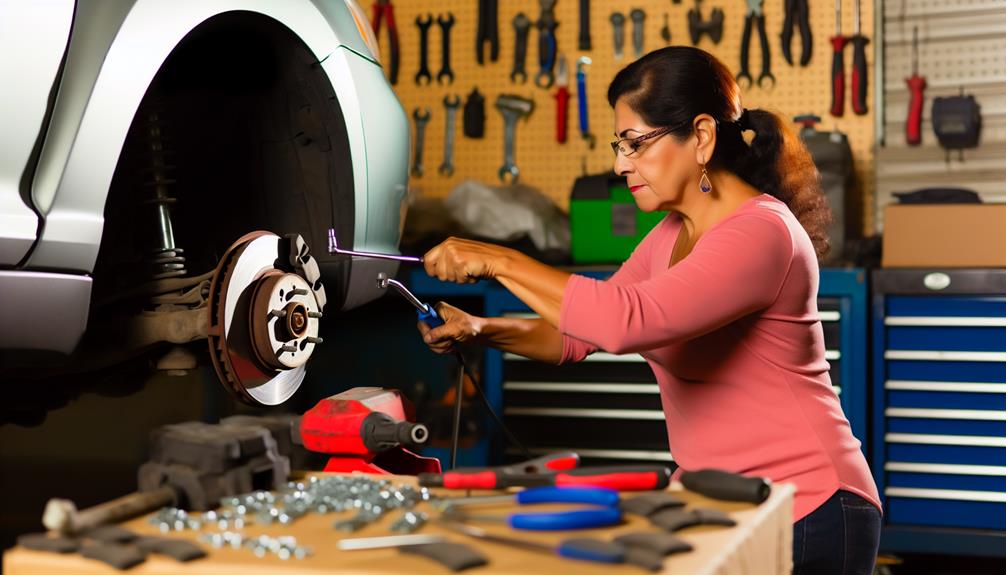You're driving down the road, enjoying a peaceful ride in your newly imported car, when suddenly you feel a slight vibration through the brake pedal. Could it be a sign of a brake problem?
In this guide, we will explore the common brake issues that can arise in imported and foreign cars, and provide you with the signs of brake wear to look out for.
But that's not all, we will also share valuable brake maintenance tips and take you through the necessary brake repair procedures for foreign vehicles.
And if you're wondering how to choose the right brake parts for your imported car, we've got you covered.
So, buckle up and get ready to discover everything you need to know about brake repair for imported and foreign cars.
Key Takeaways
- Regular inspection and replacement of brake pads is crucial for imported cars to prevent brake pad wear.
- Brake fluid replacement is necessary to maintain the effectiveness of the brake system and prevent brake failure.
- Signs of brake wear in foreign vehicles include squeaking or squealing noises, vibrations or pulsations in the brake pedal, longer stopping distances, and the brake warning light illuminating on the dashboard.
- Proper brake maintenance, including regular inspections and choosing high-quality brake pads, improves vehicle safety and performance for imported cars.
Common Brake Problems in Imported Cars
If you own an imported car, you may encounter a range of common brake problems that require immediate attention and professional repair.
One of the most common issues faced by owners of imported cars is brake pad wear. Imported car brake pads are designed to withstand the demanding driving conditions and high-performance capabilities of these vehicles. However, they still wear down over time due to friction and heat generated during braking. It's important to regularly inspect the brake pads and replace them when they reach the minimum thickness specified by the manufacturer.
Another common brake problem in imported cars is the need for brake fluid replacement. Brake fluid plays a crucial role in the braking system, as it transfers the force applied to the brake pedal to the brake calipers, resulting in the application of the brakes. Over time, brake fluid can become contaminated with moisture and other impurities, which can reduce its effectiveness and lead to brake failure. It's recommended to have the brake fluid replaced at regular intervals, as specified by the manufacturer.
Signs of Brake Wear in Foreign Vehicles
When it comes to foreign vehicles, being able to identify the signs of brake wear is crucial in order to ensure the safety and performance of your car. Regular brake inspections are of utmost importance in imported vehicles as they often have different brake systems compared to domestic cars. Here are four signs of brake wear that you should look out for:
- Squeaking or squealing noises: If you hear high-pitched noises when applying the brakes, it could indicate worn brake pads. This is a common sign of brake wear and should be addressed promptly.
- Vibrations or pulsations: If you feel vibrations or pulsations in the brake pedal when you apply pressure, it may be a sign of warped brake rotors. This can affect your car's braking performance and should be checked by a professional.
- Longer stopping distances: If your car takes longer to come to a complete stop, it could indicate worn brake pads or a loss of brake fluid. This can compromise your safety and should be addressed immediately.
- Warning light: If the brake warning light on your dashboard illuminates, it's a clear indication of a brake system issue. This could be caused by low brake fluid, worn brake pads, or other brake system problems. Ignoring this warning can lead to brake failure and potential accidents.
To avoid brake failure in foreign cars, it's important to schedule regular brake inspections. This will help identify any potential issues early on and ensure that your brakes are functioning optimally. Remember, your safety and the safety of others on the road depend on properly maintained brakes.
Brake Maintenance Tips for Imported Cars

To properly maintain the brakes of your imported car, it's essential to follow these brake maintenance tips. Proper brake maintenance not only ensures the safety of your vehicle but also improves its performance.
Two crucial aspects of brake maintenance for imported cars are brake fluid replacement and brake pad selection.
Brake Fluid Replacement:
Brake fluid plays a vital role in the braking system of your imported car. Over time, brake fluid can become contaminated, which can affect its performance. It's recommended to replace the brake fluid every two years or as specified by the manufacturer. Regularly checking the brake fluid level and ensuring it's at the recommended level is also important.
Brake Pad Selection:
Choosing the right brake pads for your imported car is crucial for optimal braking performance. Different brake pads have different characteristics and are designed for specific driving conditions. When selecting brake pads, consider factors such as the type of driving you do, the climate you live in, and the manufacturer's recommendations. It's advisable to choose high-quality brake pads that offer excellent stopping power and durability.
Brake Repair Procedures for Foreign Vehicles
To effectively address brake repairs for foreign vehicles, it's crucial to understand the specific maintenance requirements and procedures necessary to ensure optimal braking performance. Here are four key steps to follow when conducting brake repairs on foreign vehicles:
- Diagnostic Assessment: Begin by using specialized diagnostic tools to identify any brake system issues. These tools help pinpoint the problem, whether it be worn brake pads, damaged rotors, or a faulty brake caliper. Conduct a thorough inspection to determine the extent of the repair required.
- Brake Repair Tools: Utilize a variety of specialized tools designed for foreign vehicles to perform the necessary repairs. These may include brake piston rewind tools, brake bleeders, and torque wrenches. The right tools ensure that the repair is done accurately and efficiently.
- Component Replacement: Replace worn or damaged brake components with high-quality, manufacturer-approved parts. This includes brake pads, rotors, calipers, and brake lines. Using genuine parts ensures optimal performance and maintains the integrity of the braking system.
- Brake Repair Cost Estimation: Before proceeding with the repair, provide an accurate cost estimation to the customer. Consider the cost of parts, labor, and any additional services required. Transparently communicate the estimated cost to the customer, ensuring they're informed and can make an educated decision.
Choosing the Right Brake Parts for Imported Cars

When choosing brake parts for imported cars, it's essential to consider the specific make, model, and year of the vehicle to ensure compatibility and optimal performance. This is especially true when it comes to brake pad selection for imported vehicles.
Brake pads are a vital component of the braking system, responsible for creating friction against the brake rotors, which ultimately slows down and stops the vehicle. For imported cars, it's crucial to choose brake pads that are specifically designed for their make and model. This ensures that the pads fit perfectly and provide the necessary stopping power without causing any damage to the braking system. Additionally, it's important to consider the driving conditions and habits when choosing brake pads.
For example, if you frequently drive in high-performance situations or in extreme weather conditions, you may want to opt for brake pads that are designed to withstand higher temperatures and offer improved stopping power.
Another important aspect to consider when choosing the right brake parts for imported cars is the brake rotor options for foreign cars. Brake rotors, also known as brake discs, are the flat, circular metal discs that the brake pads clamp onto to stop the vehicle. Just like brake pads, brake rotors should be chosen based on the specific make and model of the imported car.
It's important to select rotors that are compatible with the brake pads and provide the necessary stopping power. Additionally, it's crucial to consider the type of driving and conditions the vehicle will encounter. For example, if you frequently drive in hilly or mountainous areas, you may want to opt for slotted or drilled rotors that offer better heat dissipation and prevent brake fade. On the other hand, if you mostly drive in city traffic, solid rotors may be sufficient.
Frequently Asked Questions
How Often Should I Replace the Brake Fluid in My Imported Car?
You should replace the brake fluid in your imported car every two years or 30,000 miles, whichever comes first. Regular brake fluid maintenance is crucial to ensure optimal braking performance and to prevent contamination, which can lead to brake failure.
Can I Use the Same Brake Pads for My Foreign Car as I Would for a Domestic Vehicle?
Yes, you can use the same brake pads for your foreign car as you would for a domestic vehicle. However, it is important to consider the differences in brake systems and ensure compatibility.
Are There Any Specific Brake Repair Techniques Unique to Imported Cars That I Should Be Aware Of?
When it comes to brake repair for imported cars, there are specific techniques you should be aware of. These include addressing common brake problems and taking preventive measures to ensure optimal performance and safety.
What Are the Most Common Brake Problems in Foreign Cars and How Can I Prevent Them?
The most common brake problems in foreign cars can be prevented with regular brake maintenance. Follow these tips to keep your foreign vehicle's brakes in top condition and avoid costly repairs.
Are There Any Special Considerations I Need to Keep in Mind When Choosing Brake Parts for My Imported Car?
When choosing brake parts for your imported car, there are a few special considerations to keep in mind. Look for the best brake brands for imported vehicles to ensure optimal performance and safety.
Conclusion
In conclusion, maintaining and repairing the brakes of imported and foreign cars is crucial for optimal performance and safety. By recognizing common brake problems and signs of wear, and following proper maintenance procedures, you can ensure the longevity of your vehicle's braking system.
Remember to choose the right brake parts to guarantee the best fit and function. Just like a skilled mechanic, you can confidently keep your imported car's brakes in top shape.


